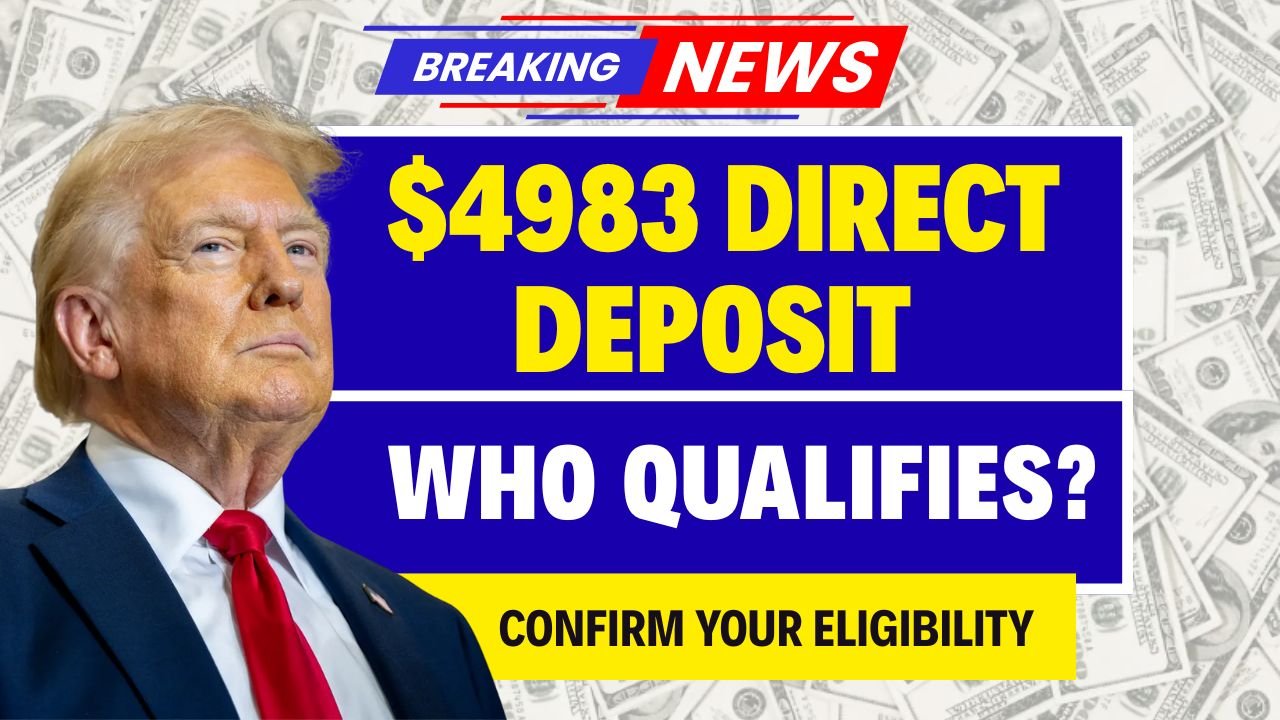For many Americans, managing the rising cost of living has become increasingly challenging. Fortunately, August 2025 brings a financial lifeline in the form of the $4983 Direct Deposit. This one-time payment is intended to provide much-needed relief for eligible recipients, helping with everyday expenses such as rent, groceries, medical bills, and other essential costs. As inflation, higher housing prices, and unpredictable job markets continue to affect households across the country, this targeted assistance could not have come at a better time.
Canada Grocery Rebate Payment 2025 – Who Qualifies and When Will You Get Paid?
If you’ve heard about the $4983 Direct Deposit but are unsure of your eligibility, how it works, or when it will arrive, this guide breaks everything down in a clear, practical manner.
Where Does the $4983 Direct Deposit Come From?
The $4983 Direct Deposit is not a random handout. It is part of a carefully planned financial assistance initiative funded by a combination of federal resources and state-administered benefit programs. Unlike previous stimulus payments during the pandemic, this payment is more targeted, directed toward individuals and families who meet specific eligibility criteria. The goal is to provide immediate support where it can make the most impact.
Importantly, this payment is not a loan. You do not need to pay it back, and there are no hidden fees or conditions. It is designed to help Americans cover urgent expenses and avoid falling deeper into debt. Eligible households can use the funds for overdue utility bills, rising grocery costs, transportation, healthcare, or simply to create financial breathing room during difficult months.
Who Qualifies for the $4983 Direct Deposit?
The $4983 Direct Deposit is not universal; it targets households experiencing financial strain. While eligibility can vary slightly by state, the following general criteria apply:
Income Limits
-
Individuals: Annual income under $75,000.
-
Married couples filing jointly: Combined income under $150,000.
-
Heads of household: Income thresholds often range from $112,500 to $125,000.
Benefit Recipients
Many recipients already receive certain public assistance benefits, such as:
-
Social Security retirement benefits
-
Social Security Disability Insurance (SSDI)
-
Supplemental Security Income (SSI)
-
Veterans Affairs (VA) benefits
Residency and Filing Requirements
-
Must be a U.S. citizen or lawful permanent resident.
-
Must have filed taxes in the last two years or updated information with the IRS or your state revenue department.
Location-Based Prioritization
Some states prioritize residents in high-cost-of-living areas or regions experiencing economic hardship.
The purpose of this targeted approach is to ensure that the $4983 Direct Deposit reaches households who need immediate financial assistance the most.
When Will the $4983 Direct Deposit Arrive?
Eligible recipients can expect the $4983 Direct Deposit between August 12 and August 22, 2025. Payments will be sent first via direct deposit if you already have bank account details linked for federal or state benefits. This ensures faster access to funds.
For those without direct deposit information, paper checks or prepaid debit cards will be mailed, possibly arriving toward the end of August or early September. While mail delivery may be slower, all payments are processed urgently to ensure recipients receive support in time.
Also Read – $1,800 Baby Stimulus Payment 2025 – Eligibility & How to Apply
How to Confirm Your Eligibility and Payment Status
To verify eligibility and track your $4983 Direct Deposit, use official channels:
-
State Benefits Portals: Many states offer online tools where you can enter your Social Security number and date of birth to check eligibility and payment status.
-
IRS Website: For federally managed programs, the IRS will provide a “Get My Payment” tool or similar tracking option.
-
Direct Contact: Call your state’s Department of Revenue or equivalent office. Note that high call volumes may result in longer wait times.
Avoid relying on unofficial sources or social media links, which could be scams attempting to steal your personal information.
How to Use the $4983 Direct Deposit
The $4983 Direct Deposit comes with no restrictions on how you use it. Recipients can allocate the funds based on their unique financial needs. Here are some common ways households might use the payment:
-
Housing Costs: Pay rent or mortgage to avoid late fees or eviction.
-
Debt Repayment: Reduce high-interest credit cards or personal loans to improve financial stability.
-
Medical Expenses: Cover prescriptions, treatments, or medical equipment not covered by insurance.
-
Groceries and Essentials: Offset rising food and household supply costs.
-
Emergency Savings: Set aside funds to prepare for future unexpected expenses.
Real-life accounts from past recipients show just how impactful these payments can be. Maria Rodriguez, a single mother from New Mexico, recalled:
“It wasn’t just about paying the bills — it was the relief of knowing I could keep a roof over my kids’ heads without borrowing money.”
Similarly, James Carter, a veteran from Ohio, said his payment allowed him to clear long-standing medical bills, providing a much-needed fresh start.
The Broader Economic Context
While $4983 is a significant sum for most families, financial experts stress that one-time payments are a temporary solution. The $4983 Direct Deposit is meant as a bridge to help households cope with high inflation, housing costs, and rising living expenses.
These targeted payments highlight the value of efficient cash assistance programs. Properly distributed, they can prevent evictions, reduce financial stress, and provide stability during uncertain economic times. For households already struggling to meet everyday needs, even a single payment can make a meaningful difference.
Protecting Yourself from Scams
Unfortunately, announcements of large-scale payments often attract scammers. Follow these precautions to stay safe:
-
The IRS and state agencies will never ask for sensitive personal information via unsolicited calls, emails, or texts.
-
Avoid clicking links in messages claiming to help you claim your $4983 Direct Deposit.
-
Forward suspicious communications to reportphishing@irs.gov or your state’s fraud reporting office.
Being vigilant ensures that your financial support reaches you safely.
Frequently Asked Questions
1. Is the $4983 Direct Deposit a loan?
No. This is a one-time payment you do not have to repay.
2. Will everyone receive it?
No. Only eligible households meeting income, residency, and other criteria will qualify.
3. Do I need to apply?
Most recipients do not need to apply. If your information is already on file with the IRS or state benefits office and you meet the requirements, payment is automatic. Some states may require updates to personal information.
4. What if I don’t have direct deposit set up?
You’ll receive a paper check or prepaid debit card via mail. Delivery may take longer, so ensure your mailing address is current.
5. Will this affect my taxes?
Generally, no. These payments are not taxable income, though consulting a tax professional is always recommended.
Final Thoughts
The $4983 Direct Deposit for August 2025 represents a crucial form of relief for thousands of Americans. While it is not a permanent fix, it can bridge the gap between falling behind and catching up financially. Whether used to pay debts, cover essential living costs, or create a small savings buffer, this one-time payment offers immediate support at a critical time.
If you think you might be eligible, it’s wise to verify your status through official IRS or state resources. Spending just a few minutes to check could secure nearly $5,000 in essential financial assistance, helping you navigate the challenges of today’s economy with greater peace of mind.
Toyota RAV4 2025: 35 KMPL Mileage, Rugged SUV Performance & ₹18,500 EMI Limited-Time Offer
Some Important Link
| Download News APP | Click Here |
| WhatsApp Group | Click Here |
| Home Page | Click Here |





